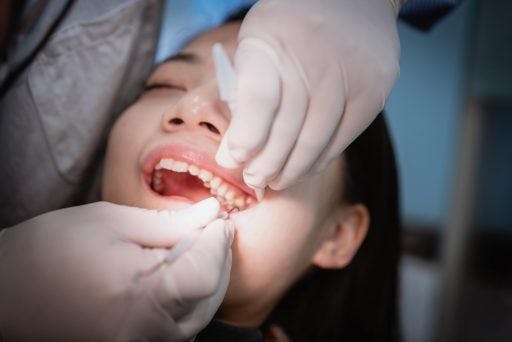Let’s face it. Few things are more unpleasant than a tooth extraction. While methods today have made the actual procedure more comfortable and pain-free, the dread comes from the downtime that comes after.
Don’t worry if your dentist tells you you need a tooth extracted—or more than one, in the case of wisdom teeth. It’s generally a safe and straightforward procedure. That said, you could be looking at a recovery period of one to two weeks, depending on the nature of the extraction. But with the proper aftercare, you can speed up your healing after tooth extraction.
Why do I need a tooth extraction?

So why would you need a tooth extraction in the first place? Usually, a dental specialist recommends a tooth extraction when a tooth has become infected beyond repair and a root canal can no longer save it from further damage.
That said, there are other reasons your dentist might suggest a tooth extraction. Here are some of them:
Trauma
Your dentist may recommend extraction if you injure your tooth, like a severe crack or break, beyond repair.
Gum disease
Gum disease can damage supporting structures of the teeth, such as the gums and bones. Affected teeth can become loose and may require extraction.
Impacted teeth
An impacted tooth fails to erupt fully or properly into the mouth. This is most common with wisdom teeth that do not grow out properly. Impacted teeth can cause pain, swelling, and infection
Overcrowding
Overcrowded or crooked teeth happen when there isn’t enough space in the mouth for your pearly whites to fit properly. In some cases, tooth extraction may be necessary to create space for proper teeth alignment and bite.
Orthodontic treatment
Your dentist may recommend tooth extraction to prepare your mouth for orthodontic treatment, such as braces or aligners.
While braces remain a popular way to straighten your teeth, a comfortable and non-intrusive alternative is ClearCorrect. These invisible aligners use a revolutionary tri-layer ClearQuartz material, a flat trimline, and other customisable features to create a personalised teeth-straightening solution.
How to prepare for a tooth extraction
There are many reasons your dentist might recommend a tooth extraction. If a tooth is damaged beyond repair, your dentist might call upon the services of an oral surgeon. Even healthy teeth such as unruly wisdom teeth or dental implants can require pulling sometimes.
Regardless of why you need an operation, here are some ways to prepare for a successful tooth extraction.
Ask for and understand pre-op instructions.
Your dentist will most likely have a preoperative and postoperative plan in place for you. Prepare a list of questions so you can discuss any alternative options and clarify misunderstandings you might have about your tooth extraction. Getting answers will also help put you at ease and give you the peace of mind you need before the big day.
Give your complete and accurate medical history.
The oral surgeon will inquire about your medical history. Include any crucial details, especially anything related to heart issues, bleeding disorders, high blood pressure, or immune-related conditions.
Being thorough will prevent potential complications and allow your dentist to give you a more comprehensive surgical plan. It will also enable you to anticipate and keep tooth extraction costs as low as possible.
Decide on which type of anaesthetic you prefer.
Your oral surgeon or dentist might use local or topical anaesthesia for simple tooth extractions. However, more major work might require general anaesthesia. Ask your dentist about your options if you’re uncomfortable with blood or getting knocked out.
Moreover, familiarise yourself with the type of painkillers that your dentist plans to prescribe. Identify those that have worked well for you or triggered a negative reaction. Do your homework before the procedure to avoid a difficult recovery.
Arrange for transportation and time off.
Having someone with you for your tooth extraction is nice for moral support, but the real need comes when you can’t drive yourself home. If you don’t find anyone to pick you up after your procedure, hire a taxi in advance to take you home.
While you’re at it, ask someone to look after your kids or take over any household work so you can focus on getting the rest you need. Take a few days off work, too. Keep in mind, you’ll have to limit talking or other strenuous activities after surgery.
If you play your cards right, maybe you can stretch your recovery time out a little longer to catch up on that Netflix series you bookmarked.
Don’t eat before your surgery.
Eating is typically off the table before your tooth extraction. Be prepared for your dentist to instruct you to do a 12-hour fast before your procedure. Ask your dentist if you need to avoid anything else before the surgery, though this may be unnecessary if you’re getting local instead of general anaesthesia.
Smoking is also not advised 12 hours prior and 24 hours afterward. It may increase your risk of developing a dry socket in your mouth, which can be painful and might affect healing.
Go through your aftercare beforehand.
How can you make your tooth extraction recovery period quicker and less painful? Adequate preparation for post-surgery care is the only answer. Go through your dentist’s instructions carefully. Stock up on the items you need for tooth extraction aftercare as early as a few days before the procedure.
Some other precautions might include:
- Taking painkillers when necessary
- Icing the extraction site for 10 minutes on the first day
- Bed rest
- Preparing a diet of soft and easy-to-cook or no-cook food
- Rinsing your mouth with warm water and salt solution the next day
Whether it’s doing the groceries, sticking ice packs in the freezer, or going for a painkiller run, secure your recovery kit ahead of time so you’re not scrambling for things when you’re groggy and incapacitated.
Get a good night’s sleep.
It might be easier said than done since you’re probably going to be a ball full of nerves the night before your operation, but getting a full eight hours of uninterrupted sleep before your surgery will help calm any anxieties you might have about your tooth extraction. Arrive earlier than scheduled to settle in and relax before game time.
Tooth extraction healing: how to recover quickly

Aftercare is crucial to ensuring a quick and complete recovery. Remember that some people will naturally heal more quickly than others and the time it takes to heal from a tooth extraction can vary depending on the procedure. For example, impacted wisdom tooth extraction recovery may take longer as the wounds may be larger or deeper.
It can take up to two weeks to fully heal from a tooth extraction.
Here are some tips to help speed up your tooth extraction recovery time. These include best practices to keep the site clean and reduce discomfort as well as what to eat after a tooth extraction.
Practise good oral hygiene.
Practising proper oral hygiene is essential if you want to hasten your recovery. Your dentist will tell you specific instructions on how to care for the extraction site, including how often to change your gauze, how to brush your teeth, and what food to avoid. Follow these to a tee to promote faster healing.
Get lots of rest.
Rest is necessary for a quick recovery from a tooth extraction. Avoid strenuous activities such as bending over or lifting heavy objects during the first few days, as this can increase blood pressure and cause bleeding.
Keep the extraction site clean.
Keep infection at bay and help yourself heal faster by keeping the extraction site clean. Skip brushing a day or two after your surgery – instead, rinse your mouth gently with warm salt water after meals and before bed. After a few days, however, gently brush the area to remove any food particles or debris.
Apply ice packs to reduce swelling.
Cold therapy can help reduce swelling and relieve pain. Apply an ice pack to your cheek for 20 minutes at a time, with at least 20 minutes between applications. Do this 24 to 48 hours after the procedure, at the height of swelling and pain.
What not to do after a tooth extraction
Now that you know what you can do to speed up your recovery, it’s important to also understand what you shouldn’t do. Some foods or activities can delay healing or even lead to an infection.
Avoid smoking or using a straw while drinking.
When you drink through a straw or smoke, you suck air in and create negative pressure in your mouth. This can dislodge the blood clot and cause a dry socket.
Stay away from alcohol.
It’s best to avoid alcohol at least 24 hours after the procedure – and ideally for several days or weeks. Drink lots of water instead.
Don’t eat hard, chewy, or crunchy foods.
Crunchy, chewy, spicy, or acidic dishes can irritate or even reopen the wound.
Don’t brush your teeth or rinse your mouth for 24 hours.
In the first day after your procedure, avoid brushing your teeth or rinsing your mouth, especially with harsh mouthwashes. You can start gently rinsing your mouth with a salt gargle in the morning and before bedtime about a day after the surgery.
What to eat after a tooth extraction

Do not chow down on trail mix at all costs. Instead, choose soft, nutritious foods that are easy to chew and swallow. Here are some suggestions you can enjoy while in recovery:
- Yoghurt or other frozen dairy products
- Rice porridge
- Oatmeal
- Mashed potatoes
- Soup
- Scrambled eggs
And if you’re wondering, ‘When can I eat solid food after tooth extraction,’ you should go at your own recovery pace. Avoid solid food for at least the first 24 to 48 hours, up to a week, depending on how your healing progresses. You can start incorporating semi-solid food on the second or third day, but don’t push it if it causes discomfort.
After about a week or two, you should be able to eat solid food without a problem, though you may want to still avoid anything crunchy, hard, or sticky until your dentist or oral surgeon confirms the extraction site has fully healed.
You might need to have a tooth extraction at some point in your life. According to the Healthy Journal, 90% of Americans have their wisdom teeth removed. Premolar extraction is one of the strategies to resolve overcrowding, which can make you more prone to decay and cavities, bad breath, and even enamel damage. It also creates space for teeth alignment.
Have any tooth extraction done before you start teeth alignment for the best chances of successful treatment. Consult your dentist if you need to follow up your treatment with dental aligners, such as ClearCorrect.
ClearCorrect uses a ground-breaking ClearQuartz material that pushes your teeth firmly but gently in place. These aligners are clear and thin, with a high trimline – a combination of features that make them subtle and comfortable to wear all day. You can take an online smile assessment to determine if you’d be a good candidate for clear aligners.
You don’t have to be afraid of tooth extraction. Follow these tips to make the process easier – and you might just end up with better, straighter teeth than before.
References:
The Healthy Journal – Gluten, Dairy, Sugar Free Recipes, Interviews and Health Articles. (n.d.).
Australian Government – Department of Health and Aged Care. (n.d.). Tooth Extraction. Healthdirect.gov.au



